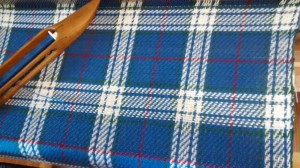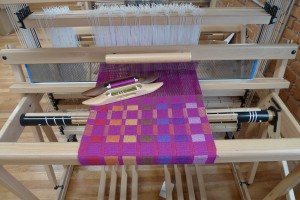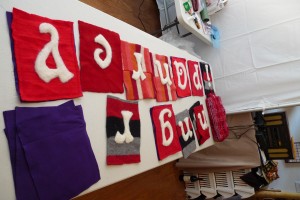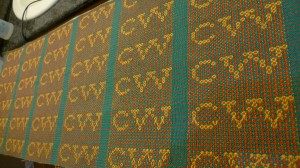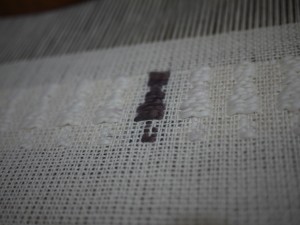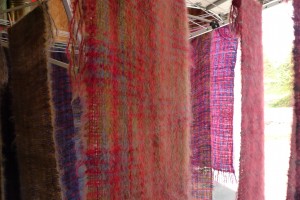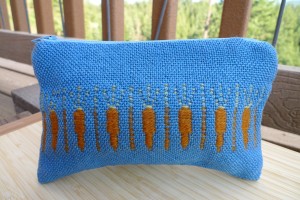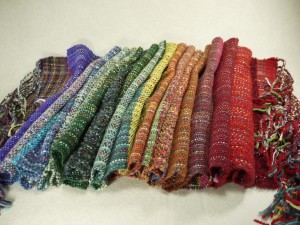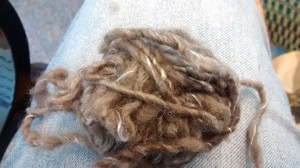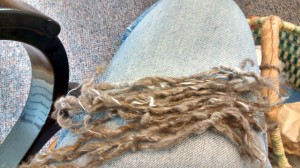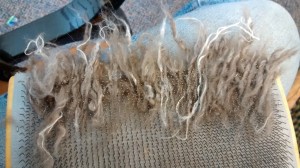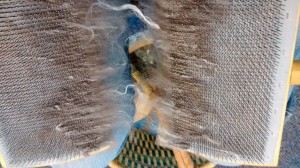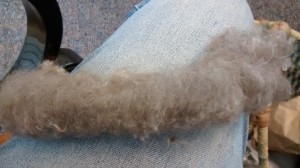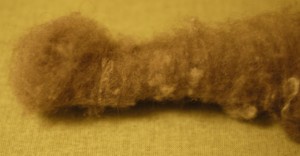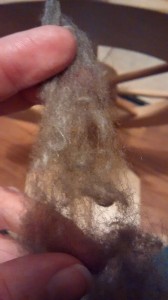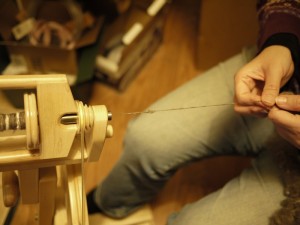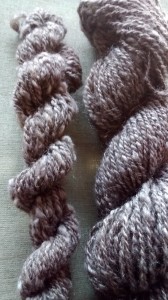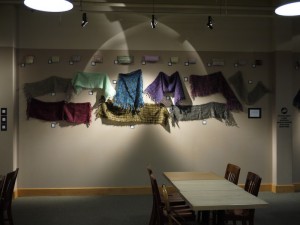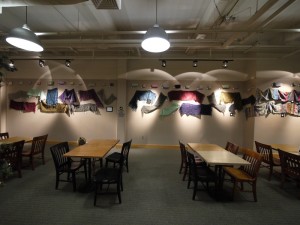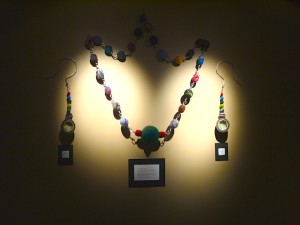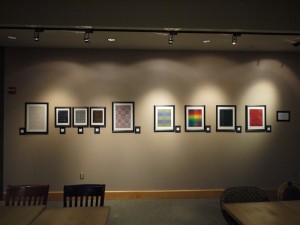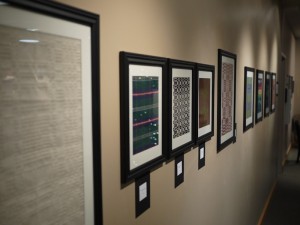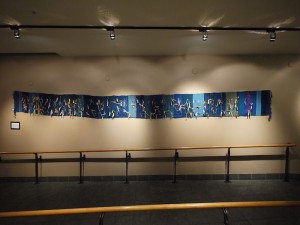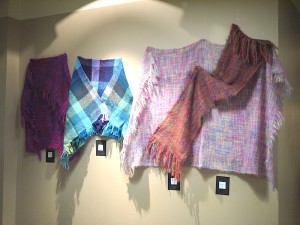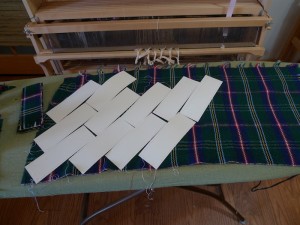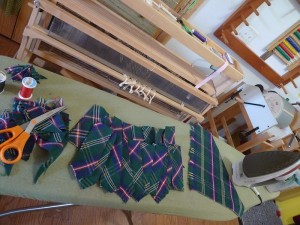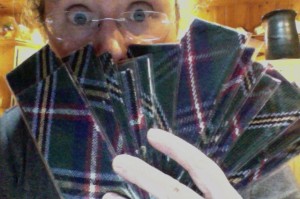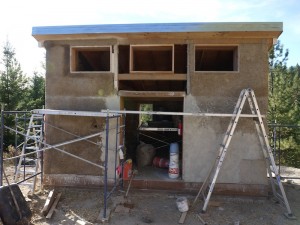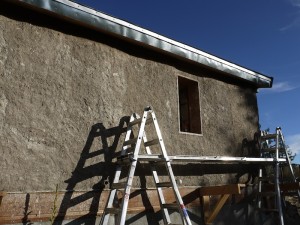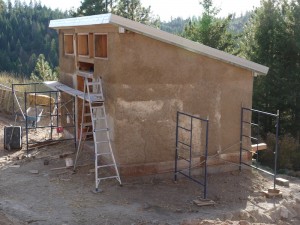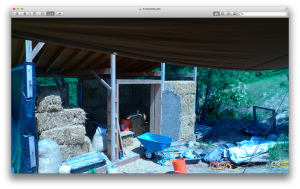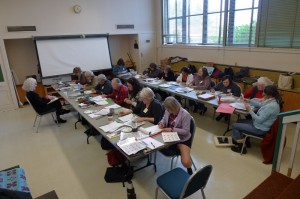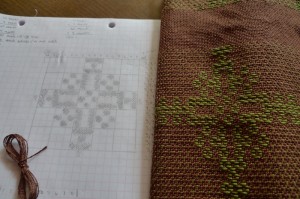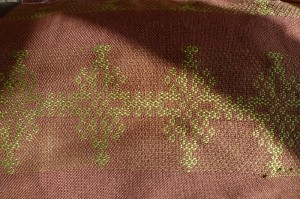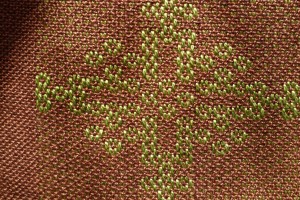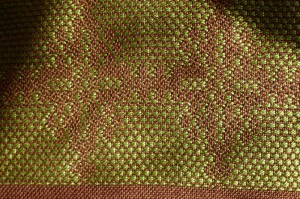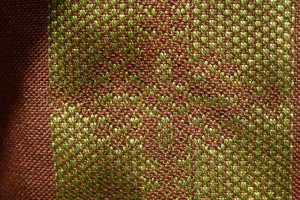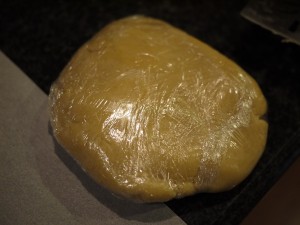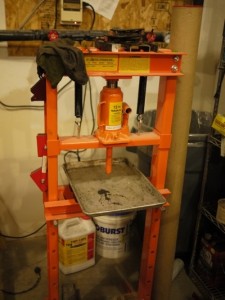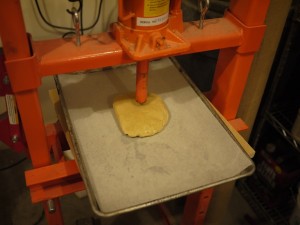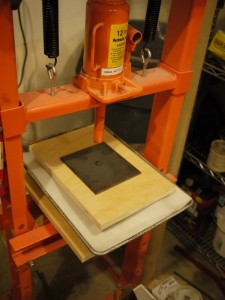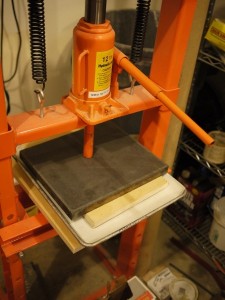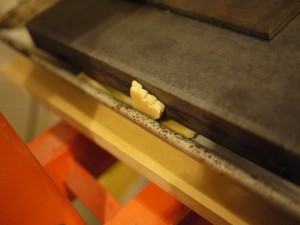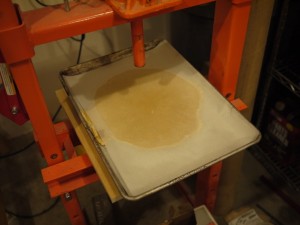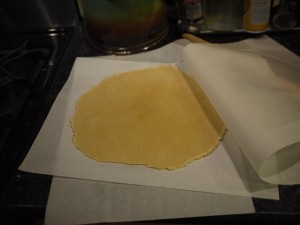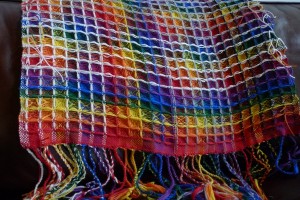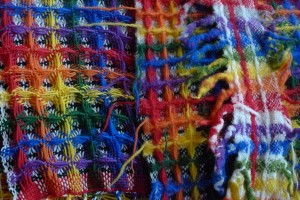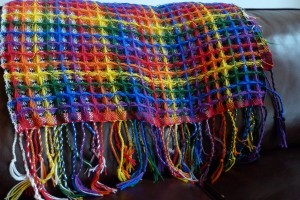Tartan Legacy Day
I showed up in the Spokesman Review weaving on the quad at the Gonzaga Tartan Legacy Day. It was a blast, and the cloth came out beautifully.
For curious weavers, I used a sett of 12 epi using sport weight Brown Sheep Naturespun yarn in Natural, Irish Shamrock, Nordic Blue, and Scarlet, sourced locally at Paradise Fibers.
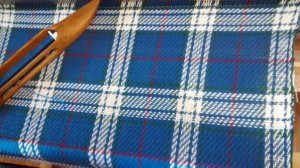 I will have it at the 13 May meeting of the Spokane Handweavers’ Guild in Spokane Valley, if you’d like to see the finished product. I fulled it further than I intended, which makes me a wee bit sad, but it would make a GORGEOUS blanket at that weight.
I will have it at the 13 May meeting of the Spokane Handweavers’ Guild in Spokane Valley, if you’d like to see the finished product. I fulled it further than I intended, which makes me a wee bit sad, but it would make a GORGEOUS blanket at that weight.
As we learned at the last guild meeting, blue DOES in fact felt at a different rate than the other colours, so I also had puckering of the white squares, which I worked out with a makeshift mangle (large rolling pin) and lots of elbow grease.
Musk Ox and Silk
My spinning client send me musk ox (so very soft!) and silk (for strength) to spin.
Some of it had been spun before, and she wondered if I could take it back apart.
It was loosely spun, and the musk ox is short, so I started by teasing the yarn into short strips.
I held the strips and charged the carders with it.
Looking good. So I started carding back and forth.
The fibers opened up nicely and the blending went really well: here’s the resulting rolag:
After just an hour, I got the yarn back to fibers, and the rest of it processed. On to the spinning!
Unfortunately, the spinning and un-spinning resulted in some of the musk ox felting on itself. This happens with really fine fibers — too much handling results in felting. It’s basically the same thing that happens when a fabric pills. Here’s one of the rolags that shows that:
And a close up:
Fortunately, I noticed this early, and I separated out the rolags with the damage from the ones that weren’t. Here’s what happens in the spinning when you encounter the wee nubbies:
(Click to enlarge and get a good view of the nub). Yarn with these nubbies intentionally placed can be gorgeous and interesting — they add a tweedy texture to the yarn and make beautiful cloth. However, since so much of the musk ox was NOT damaged in this way, I wanted to preserve the smooth nature of the bulk of the yarn, so I spun two separate skeins: one smooth and a smaller nubby one.
Kress Gallery Show
The Kress Gallery Show (3rd floor of River Park Square in Spokane) is open until the 31st of January. Here’s some highlights! Click on the individual pictures to see them larger.
Some of my cloth begins as grass in my yard.
(I don’t weave grass, though there are folks who do).
The grass is is consumed by my alpacas or goats.
They, in turn, grow out fiber which I shear, clean, comb, dye, spin, ply, and then weave into cloth.
This is slow cloth, in the same way that growing, harvesting, and cooking one’s own food is slow food.
There’s something very satisfying about knowing that you can create cloth – one of the fundamentals of survival – on your own.
Brobdingnagian Jewelry
Like most artists, I’ve dabbled in a lot of different media, from paint to clay to beading to fiber. And that dabbling tends to lead to fusion.
The Brobdingnagian Jewelry is one such fusion. The wire is nine gauge, the beads are solid wool. As you might imagine, assembly took hours with an icepick, sore fingers, and several large pliars.
The Brobdingnagian lover didn’t go to Jared: he went to Jen.
Weaving Yarn and Yarns
This piece was commissioned for First Night 2014, and is the result of community participation. The piece was woven entirely over the course of First Night, with ribbon contributions from revelers. While I planned the rough dimensions and colour scheme before the event, the cloth came together as the night progressed. You can see the waves of people who came by in density of the ribbons. I tried to group families and friends together, but sometimes colour and balance won out. The early evening is to your right, the new year to your left.
About the Artist:
Jen the Angry Spinner lives in the Foothills of Mount Spokane, in beautiful Newman Lake with Farmerteen, the Renaissance Guy, her parents, a few alpacas, and an ever changing number of barn cats.
When she’s not busy fighting fires, homeschooling, or attending Spokane Handweavers’ Guild meetings, she can be found at her loom, creating cloth and half-watching Law & Order.
She can be reached at 509.280.4785 or jen@angryspinner.com
Bookmarks
My local weaving guild, the Spokane Handweaver’s Guild, is making bookmarks for the goodie bags for the ANWG Conference in Bellingham in June.
I got the extremely clever idea of taking the cloth I’m currently working on (WA State Tartan in a lovely, thin wool) and using it for the bookmarks. Next, I thought I’d b clever by sewing on pre-sized, pre-cut bookmarks, and decided I could line them up and THEN cut them, saving fraying, and, in theory, keeping everything straight.
It was an awesome idea . . . but I’m still a terrible seamstress.
And the bookmarks, safely tucked into plastic sleeves that are manufactured and sold as “pretzel bags” for people who dip pretzel logs in candy coating and then roll them about in sprinkles:
Strawbale Power Shed
Click on individual pictures to see larger image.
A smarter person would have started work on the back of the building, and done all sampling there, too. However, the back of the building is accessed via a ladder scaffolding overhanging a rather steep drop, so I began on the front righthand side, and worked my way counterclockwise to the front left. I’ve also started my finish plaster sampling on the front (that’s the lighter splotchy stuff on either side of the door).
If you look carefully at the left corner of the building, just under the scaffolding, you can see a smoother bit that is the patch I made to replace the 2 foot long section of plaster that fell when the excavator ran into the side of the building. The hole in the middle of the left side is where I will put a wine bottle “window” when I get home and finish the pinot gris that’s in the second bottle, and get the glass cut.
Before I could leave to the Complex Weaver’s Seminars, I had to finish the base plaster, which I did on all parts of the exterior, with the exception of the front above the door. As you can see, there will be a third window above the double door, but I didn’t have any wall to which to plaster, so that will happen next week, along with continuing the finish plaster (which I expect will go quite quickly).
The window here seems ever-so small, but it’s large enough to climb through quite easily (or to set four 2-gallon buckets in the frame — though not both). I was very happy to have made it across the wall — from there, the remaining two walls were so much shorter. (Also, not pictured, the scaffolding is ladder scaffolding, because full-size scaffolding won’t fit on the very small ledge that is immediately before the drop-off down the hill).
I did quite a bit of experimenting on this side of the building, too. You can see a number of different plaster colours (there are 4 major kinds of dirt on the site, and I was trying to determine which might work best). My inlaws also dug out a bit of their crawl space (too sandy), and I dragged some extremely heavy water-soaked clay that I dug out from the banks of the creek (not clayey enough to make it worth the hassle). The rather unfortunate experiment with wheat paste (hideously stinky — attempted to cover with shots of clay slip) is also visible in this picture.
The thing I find most worrisome in this picture is the crack toward the left side of the wall. It mirrors one we found in the foundation, and I am concerned that it’s there because of a transference. It does now seem to be as deep as the plaster, but I was still developing my technique of keying the different batches together, and I’m pretty sure that the fault line is between two sections. If push comes to shove, I’ll chip it out, and start again, but I’m hoping to repair it with a small amount of plaster and move on to do the inside.
Recipes for the plasters and tips coming up in a post soon. I’d hoped to do it during downtime to the conference, but apparently the photos that I thought were on the laptop are actually on the server, and the ones I can see on my computer are just ghostly images with which I can do nothing.
Blocks
The Portland Handweavers Guild hosted Blocks Workshop in February with Rosalie Neilson, and when they had a few extra seats, they let the Spokane Handweavers Guild know. I had a mental block about blocks (pun only partially intended), and jumped at the chance. What fun the weekend was!
So, of course, when I got home, I set to work on what I wanted to make, scribbling and drafting, and making notes.
I used UKI 5/2 cotton for the warp and the tabby weft, and UKI 3/2 cotton for the green pattern weft, sett at 16epi, which I think was tight enough, but I fear I need to beat a LOT more firmly if I have any hope of squaring up the project. I used a birds-eye/O tiedown of 1,2,2,1.
Pre-wash Stats:
On-loom, the warp is 16″ in the reed.
Off-loom, the width is 14 7/8″.
Each motif is 4″ wide and 5 1/8″ long.
Sample = 14 7/8″w x 11 1/2″l, fringe excluded.
Washed on a hot-normal-light load in a Staber front-loader, with a cold rinse.
Post-wash Stats:
Each motif is 3 5/8″ wide x 4 7/8″ long.
14 1/2″ wide x 11″ long, fringe excluded.
Hot Ironed and air-dried.
More stats:
(In one inch of cloth length)
On loom . . . Off loom . . PPI
12 . . . . . 12.5 . . . . in pattern
16 . . . . . 16 . . . . . 5/2 plain weave
13 . . . . . 13 . . . . . 3/2 plain weave
08 . . . . . 09 . . . . . 3/2 + 5/2 in plain weave, separate sheds
10 . . . . . 11 . . . . . 3/2 + 5/2 (ie: 10 each) in plain weave, same shed
Cut Out Cookies
After nearly 8 years in the high mountain desert of Spokane, there are a few things I still haven’t mastered. One of them is finding the right amount of (less) flour in recipes. I mixed this dough the other day, and I knew, right then, in my heart of hearts, that it was too dry, but somehow I thought some magic might happen to it in the refrigerator.
It did not. I tried to roll it out this morning, and it split and crumbled and cracked.
Michael comes along, as I’m cutting the dough to salvage it into wedges of cookie, and says, “You know what might work great?” and I say, “No. I’m not doing that.” And he says, “I haven’t told you,” to which I reply, “I already know you want to take it into the shop and press it. This never ends well for my cookie sheets.” He’s giddy. He says, “You know you want to know.” I hand him a round of the dough. “Besides,” he follows up, with a glitter in his eye, “I already wrecked* the set of pans I’m going to use.”
Yup. That’s a pretty bad cookie sheet.
You’ll be happy to know that he protected the dough with sheets of parchment paper.
Working to get equal weight distribution — the first round had a high point.
Even better weight distribution!
The presser decided the bits that squeezed out needed eatin’.
Cookie dough, freshly pressed by a 12 ton press.
And presented to the baker, for cutting and baking.
*This refers back to an incident in the late 90s, when he decided to “dry” some pea gravel that he wanted to fill the legs of the doctor’s table he bought to use in his wood shop, so it wouldn’t wobble. He spread the pea gravel out on baking sheets, and set them in the grill. He managed to kill both pans AND a set of professional-grade oven mitts. Confronted with this, he said, “Gravel gets really hot — who knew?”
Fresh Off the Loom
I’ve been working on getting down a waffle weave . . . my first attempt (not pictured) ended in not-a-waffle-weave when I mis-tread the entire piece in some crazed new-weaver euphoria.
Some project history:
I’ve been playing around with colour wheels, and thought that it would be interesting to use waffle-weave to create a mix of colours. I usually use graph paper to dink around with designs:
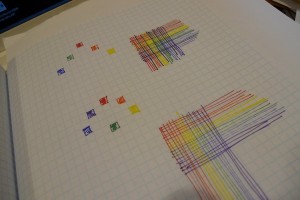
(Some are prettier than others):
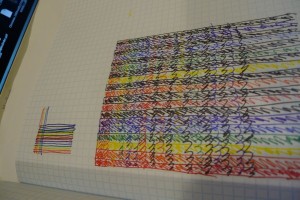
My idea was to use the waffle-weave to enhance the colour. I thought it would look cool to “box in” each of the coloured squares with white, grey, and black. I didn’t have enough space on the loom to do two reps, so I added a stripe of boxed-in-colour to the mix. In retrospect, I think I would have ordered it: colour, white, grey, black.
This project got off to a rocky start when I realized I had chosen a really bad green for it, and that fixing that would require re-warping, but not fixing it would be worse.
You can see the “wrong” green in the sample on the right. It’s too light and it’s too heathered. (It’s also too felted — the poor sample got felted about to death, and the waffling is consequently completely lost). The sample in the middle is pretty well fulled (and not felted to death), and the final project, on the right, is not yet fulled.
Based on the samples, I decided to twist the fringe before fulling this time. I’ll update when it’s fulled and let you know how that turned out. I’m kind of partial to the “wrong” side of the cloth:
